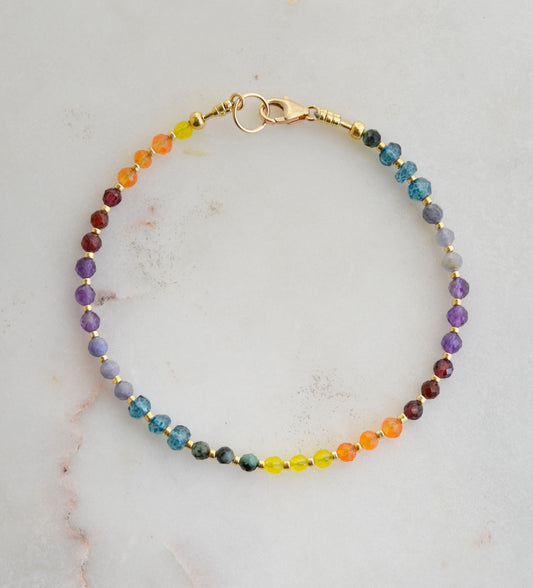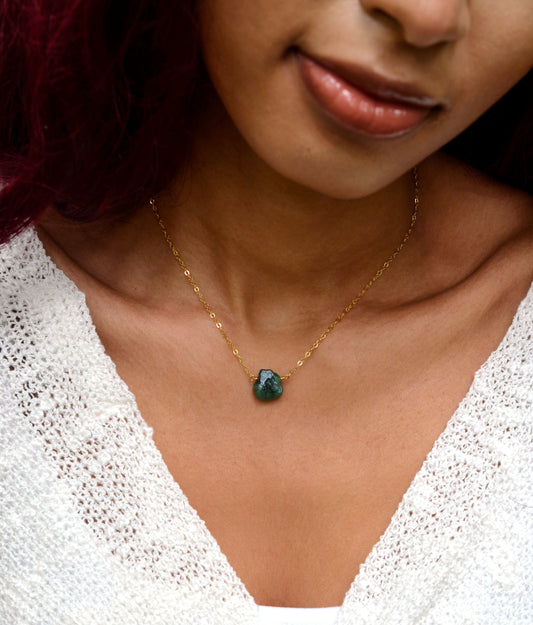Don’t swim in your jewelry… It’s okay to shower in jewelry… Crystals disintegrate in water… Soak your gems in chemical cleaner… Only wear waterproof metals….
Eeeek! There’s a lot of information out there telling us how to care for jewelry! What’s true? What’s false? We want to break it down for you metal-by-metal. Crystal-by-crystal.
For those of you looking for the quick answer: Yes, it’s okay to get jewelry wet, just dry it off after. And always, always, always keep it away from chemicals and sweat—especially when gemstones are involved.
Chemicals are sneaky things that hide in city water (chlorine), perfume, lotion, hand sanitizer, and more. So please, use discretion before showering with your jewelry or spraying your favorite perfume where you’re displaying a bracelet or earrings.
And why is sweat a problem? Sweat is mostly water, but it also contains salt, fatty acids, and ammonia. These things can eat away at metals and stones. So be sure to remove your jewelry before that workout or wipe it down when you’re done.
That’s the gist of it, but if you’re a little nerdy like us and want a more detailed answer, we’ve got you.
There’s two things to keep in mind when caring for jewelry: Metal & Gemstones. First, let’s go over metal. Below are the metals we use in our jewelry and how to care for them.
14k GOLD FILLED:
14k gold-filled is a thick layer of 14k gold, over brass. It’s 100 times thicker than gold plate and is typically great for those with allergies to metal. It’s highly durable, will not discolor your skin, and is perfect for everyday wear.
With time and wear, it can dull a little (usually because it’s dirty), but it should not tarnish. If your gold filled has tarnished, its surface was probably scratched or exposed to a chemical that stripped off the gold, revealing the brass. And guess what? Brass tarnishes when exposed to oxygen. Yikes. So, we need to prevent this from happening in the first place. How? Yeap, you guessed it, keep gold-filled clean from chemicals. And long days at the beach, where sharp things like sand can claw it.
How to clean your gold-filled jewelry: Use lukewarm soapy water and a soft brush (like a toothbrush), and gentry scrub the metal clean. Dry it when done. Do this when your piece looks dull or after exercising, swimming, or if you think it has been doused in something unfriendly. Stay away from chemical cleaners and polishing cloths.
STERLING SILVER:
Silver wants to be worn! The oils in our skin keep it from tarnishing. Watch out for pools and hot tubs, though—they often have heavy amounts of chlorine, which can cause a discoloration that’s hard to reverse. When not wearing your sterling, store it in a baggy to keep it from oxidizing.
How to Clean Sterling Silver: If it has tarnished, use a polishing cloth or silver cleaner to get it looking brand new again. Just be mindful not to get any cleaner on gemstones. If you don’t have either, mix baking soda and water to form a paste slightly more watery than toothpaste. Then, soak the piece in it overnight. By morning, wash off the paste and your silver should be much cleaner. Repeat as needed.
VERMEIL:
Our Vermeil jewelry has a layer of 18-24k gold over sterling silver. This metal requires some care, as it can tarnish, but cannot be polished. Store it in a sealed baggy when not worn, and remove it before exercising, swimming, or bathing. Chemicals and saltwater can strip the gold off, leaving you with a solid piece of sterling silver.
24k GOLD OR STERLING SILVER ELECTROPLATE:
This is a fine layer of gold or sterling silver electroformed over copper. Like Vermeil, electroplate can tarnish, so it’s recommended to store it in a sealed baggy and to remove it when exercising, swimming, or bathing.
Now for our favorites… Gemstones & Crystals!
Which ones are safe to get wet?
Please note, we are discussing crystals in jewelry, not crystals for making crystal water. Please research elsewhere if learning to make crystal water, as some minerals are dangerous to consume.
Ways to tell your crystal jewelry is not safe for water:
We’re generalizing here, but typically anything under 6 on the Mohs Hardness scale is a no go with water. The Mohs Hardness scale measures how hard minerals are by scratching them against each other. Diamonds are the hardest at a 10, Lapis Lazuli is between a 6 & 5, while Talc is among the softest at 1. Of course, there are exceptions to this rule, (ahem, Emeralds) but it is a good basic tool to go by.
Another way to tell is mineral names that end in “ite.” There is no scientific reasoning for this when it comes to water—it’s more of a coincidence. For example, Selenite, Malachite, Fluorite, and Calcite all should avoid water. Selenite will eventually disintegrate if repeatedly exposed to moisture.
Lastly, crystals that are high in iron ore or copper will corrode if they get wet. How do you know which ones have high amounts of iron and copper? Basically, if it looks metallic, keep it away from moisture until you can research it. Examples include: Pyrite, Hematite, or Magnetite.













